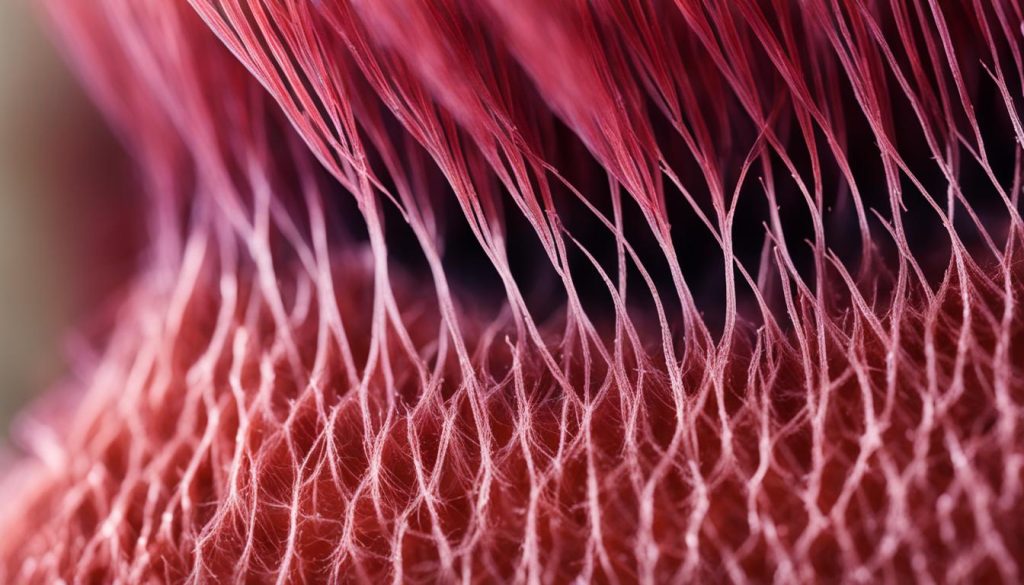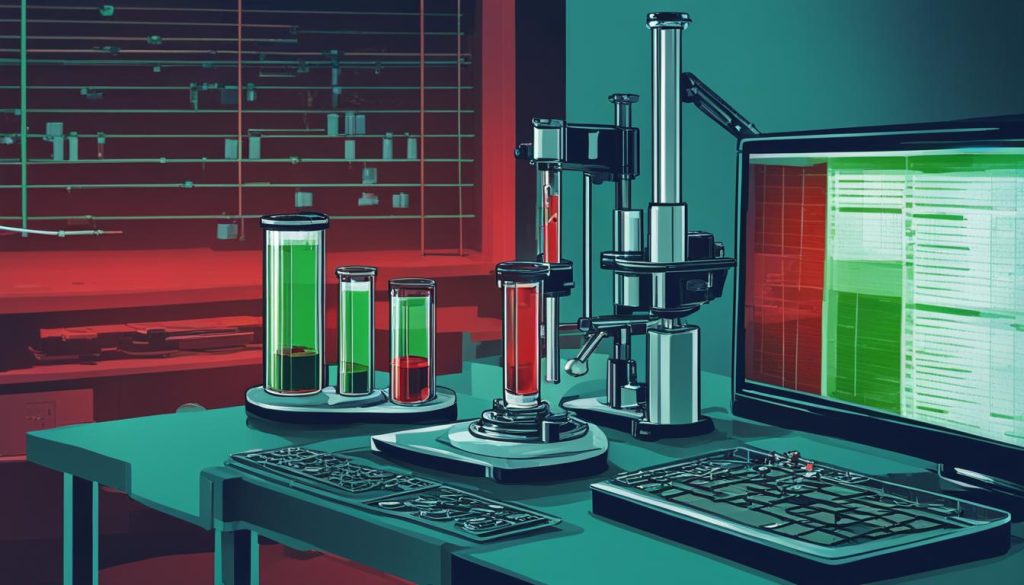
As experts in the field, we often receive questions about whether chronic cannabis users can pass a drug test. It’s an important topic to explore, considering the potential consequences individuals may face if they fail a drug test. In this article, we will delve into the factors that determine the duration of marijuana detection in the body and provide insights into the various drug tests commonly used.
Key Takeaways:
- The duration of marijuana detection in the body varies depending on factors such as frequency of use, metabolism, and hydration.
- THC can be detected in different specimens, including hair, urine, saliva, and blood, for varying periods of time.
- Chronic marijuana users may test positive for THC even days or weeks after use due to THC buildup in fatty tissues.
- Urine tests are the preferred method of drug testing for marijuana due to the high concentration of THC in urine.
- Attempts to beat a drug test using detoxification kits or other methods are not supported by scientific evidence.
How Does Your Body Process THC?
When it comes to understanding how your body processes THC (tetrahydrocannabinol), it’s important to know that THC is absorbed into various body tissues and organs after marijuana use. Once absorbed, THC is metabolized by the liver into two main metabolites: 11-hydroxy-THC and carboxy-THC. These metabolites are then excreted through your feces and urine. Approximately 65% of cannabis is excreted through feces, while about 20% is excreted through urine.
In chronic marijuana users, THC builds up in fatty tissues faster than it can be eliminated, leading to positive drug test results even days or weeks after use. This is because THC stored in body tissues is gradually released back into the bloodstream and metabolized by the liver. The half-life of THC, which is the time it takes for the concentration of THC to decrease by half, ranges from 1.3 days for infrequent users to 5-13 days for frequent users.
To summarize, your body processes THC by absorbing it into various tissues and organs, metabolizing it in the liver, and excreting it through feces and urine. In chronic users, THC can remain in fatty tissues for an extended period of time, leading to positive drug test results even after a significant amount of time has passed since marijuana use.
| THC Metabolism | |
|---|---|
| THC Absorption | Various body tissues and organs |
| Metabolism | Liver |
| Main Metabolites | 11-hydroxy-THC and carboxy-THC |
| Excretion | Feces (65%) and Urine (20%) |
| Half-Life | 1.3 days (infrequent users) to 5-13 days (frequent users) |
How Long is Marijuana in Your System?
When it comes to marijuana use and drug testing, one key question often arises: how long does marijuana stay in the body? The answer to this question depends on various factors, including an individual’s frequency of use, metabolism rate, and hydration level.
THC, the psychoactive compound in marijuana, can be detected in different specimens for varying durations. For example, THC can be detected in blood for up to 12 hours, saliva for about 24 hours, and urine for up to 30 days, depending on the frequency of use. In hair, THC can be detected for up to 90 days, making it a longer-term indicator of marijuana use.
To better understand the duration of THC detection, let’s take a look at the half-life of THC. For infrequent users, the half-life of THC ranges from 1.3 days, meaning it takes roughly 1.3 days for half of the THC to be eliminated from the body. However, for frequent users, the half-life can range from 5 to 13 days, indicating a slower elimination process.
Table: Duration of THC Detection
| Specimen | Duration of THC Detection |
|---|---|
| Blood | Up to 12 hours |
| Saliva | About 24 hours |
| Urine | Up to 30 days |
| Hair | Up to 90 days |
It’s important to note that these detection windows are estimates and can vary depending on individual factors. Additionally, the sensitivity and specificity of the drug test can also impact the detection period. Factors like gender, body mass index (BMI), overall health, and genetics may also play a role in how long THC remains detectable in the system.
Saliva Test
The saliva test, also known as the mouth swab test, is a quick and non-invasive drug test used to detect THC in the mouth. Unlike other drug tests that rely on urine or blood samples, the saliva test has a shorter detection window of approximately 24 hours. This makes it ideal for detecting recent marijuana use.
When marijuana is consumed, THC is absorbed into the bloodstream and eventually makes its way to the mouth. This absorption process leads to increased concentrations of THC in the saliva for several hours after use. The saliva test detects the presence of THC in the oral fluids, providing an indication of recent marijuana use.
The saliva test is popular for several reasons. It is easy to administer and does not require specialized equipment or trained personnel. Additionally, it provides real-time results, making it an effective tool for immediate drug screening. However, it is important to note that the saliva test has a relatively short detection window compared to other drug tests.
Overall, the saliva test is a valuable tool for detecting recent marijuana use. Its quick and non-invasive nature makes it a convenient option for drug testing purposes. However, it is essential to consider other factors such as the frequency of use and the individual’s metabolism when interpreting the results of a saliva test.
Urine Test
When it comes to drug testing for marijuana, urine tests are the preferred method due to the high concentration of THC that can be detected. THC, the psychoactive compound in marijuana, is metabolized by the body and excreted through urine. This means that urine samples can provide a longer detection window compared to other specimens.
The duration for which THC can be detected in urine depends on several factors, including the frequency of use. For infrequent users, THC can be detectable in urine for up to 1-2 days after use. However, for chronic users or individuals with high levels of THC in their system, urine tests can detect THC for up to 30 days or longer. It’s important to note that the detection window can vary depending on the sensitivity of the test and the cutoff level used.
Table: THC Detection Window in Urine
| Frequency of Use | Detection Window |
|---|---|
| Infrequent Use | 1-2 days |
| Frequent Use | Up to 30 days or longer |
It’s worth noting that urine tests can detect the presence of THC, but they do not indicate impairment at the time of testing. THC can remain in the body even after its effects have worn off. Therefore, it’s important for employers and testing authorities to consider additional factors when interpreting the results of a urine drug test.
Hair Test
A hair test is one of the most reliable methods of detecting THC in the body. It has a long detection window of up to 90 days, making it an effective tool for identifying marijuana use. Hair testing works by analyzing hair follicles to detect the presence of THC and its metabolites, specifically 11-nor-9-carboxy-THC (THC-COOH). This type of drug test is often used in legal and employment settings due to its accuracy.

Reliability of Hair Testing
The reliability of hair testing is primarily due to the fact that THC and THC metabolites become incorporated into the hair shaft as it grows. This means that even after marijuana use has ceased, traces of THC can still be detected in hair samples. However, it is important to note that hair testing is more effective at detecting heavy and regular cannabis use, as opposed to occasional or light marijuana consumption. Additionally, hair color and treatment can potentially affect the results of a hair test, although the impact is minimal.
It is worth mentioning that hair testing has faced some criticism for potential false positives or false negatives. Factors such as environmental exposure to marijuana smoke or handling marijuana can lead to the contamination of hair samples, potentially resulting in false positives. On the other hand, individuals with low drug metabolite levels or those who have recently bleached or chemically treated their hair may produce false negatives. Therefore, hair testing should be interpreted in conjunction with other forms of drug testing and clinical assessment to ensure accurate results.
| Pros | Cons |
|---|---|
| Long detection window (up to 90 days) | Potential for false positives |
| Highly accurate | Potential for false negatives |
| Indicates heavy or regular cannabis use | Potential impact of hair color and treatment |
Blood Test
A blood test is one of the less commonly used methods for detecting THC in the body. This is because THC remains in the bloodstream for a relatively short amount of time. After ingestion, THC concentrations in the bloodstream rapidly decrease within approximately 3-4 hours. As a result, blood tests may not be the most effective method for detecting recent marijuana use.
However, blood tests can still provide valuable information about recent marijuana use in certain situations. For example, they may be used in legal contexts to determine if an individual is impaired by marijuana while driving or operating machinery. Blood tests are also occasionally used in medical settings to monitor THC levels in patients using medical marijuana.
It’s important to note that blood tests do not provide information about past marijuana use beyond a few hours. If an individual has abstained from marijuana for a longer period of time, a blood test is unlikely to detect any THC in their system. In such cases, other testing methods like urine or hair tests may be more appropriate.

Table: Comparison of Different Drug Testing Methods
| Testing Method | Duration of THC Detection | Advantages | Disadvantages |
|---|---|---|---|
| Blood Test | Up to 3-4 hours |
|
|
| Urine Test | Up to 30 days |
|
|
| Hair Test | Up to 90 days |
|
|
Factors Impacting THC Detection
When it comes to detecting THC on a drug screen, several factors come into play. Understanding these factors is crucial for individuals who may be subject to drug testing or are curious about how long THC will stay in their system.
The factors that can affect THC detection include:
- Amount of THC in the marijuana consumed
- Route of consumption (e.g., smoking, ingestion, vaping)
- Dosage and frequency of marijuana use
- Individual’s metabolism rate and excretion routes
- Sensitivity and specificity of the drug test
- Gender
- Hydration level
- Body mass index (BMI)
- Overall health
- Genetics
Each of these factors can have an impact on how long THC remains detectable in the body. For example, individuals with a higher metabolism rate may eliminate THC at a faster rate compared to those with a slower metabolism. Additionally, hydration level and BMI can influence the rate of THC clearance from the body.
It’s important to note that drug tests can vary in their sensitivity and specificity, which can also affect THC detection. Some tests may have a lower threshold for detection, making it more likely to detect even low levels of THC.
| Factors | Impact on THC Detection |
|---|---|
| Amount of THC in marijuana | Higher THC levels may prolong detection |
| Route of consumption | Smoking may lead to faster detection compared to ingestion |
| Dosage and frequency of use | Higher dosage and more frequent use may result in longer detection times |
| Metabolism rate and excretion routes | Higher metabolism rate may lead to faster THC clearance |
| Test sensitivity and specificity | More sensitive tests can detect lower levels of THC |
| Gender | Male individuals may metabolize THC differently than females |
| Hydration level | Higher hydration may promote faster THC clearance |
| Body mass index (BMI) | Higher BMI may lead to longer detection times |
| Overall health | Individuals with liver or kidney issues may have slower THC metabolism |
| Genetics | Some individuals may have genetic variations affecting THC metabolism |
It’s essential to remember that everyone’s body is unique, and these factors can interact differently in each individual. Therefore, predicting precisely how long THC will be detectable in a drug test can be challenging. Consultation with a healthcare professional or toxicologist can provide further insights into personal THC detection timelines.
By considering these influencing factors, individuals can gain a better understanding of THC detection on drug screens and make informed decisions regarding marijuana use and drug testing.
Attempting to Beat a Drug Test
When faced with a drug test, individuals may resort to various methods in an attempt to beat the system. One such method is the use of detoxification kits, which claim to flush out toxins from the body, including THC, the active compound in marijuana. However, the effectiveness of these kits has not been substantiated by research, and their reliability remains questionable.
Another method employed to mask the presence of THC in urine samples is the use of chemicals such as soap, ammonia, or bleach. These substances are added to the urine sample in the hopes of diluting or altering its composition, rendering the drug test results inaccurate. However, laboratories have developed specimen validity tests that can detect these attempts and determine if the sample has been adulterated, diluted, or substituted.
Some individuals may even go as far as submitting synthetic urine samples, which are designed to mimic the chemical composition of real urine. These synthetic samples can be purchased online or from certain retail stores, and individuals use them as a means to pass the drug test undetected. However, laboratories are continually advancing their testing methods to detect synthetic urine, making it increasingly difficult to deceive the system.

Despite these attempted methods, it is important to note that drug testing protocols are continuously evolving to stay ahead of such tactics. Advanced laboratory techniques and specimen validity tests are implemented to ensure accurate and reliable results. It is crucial to understand that attempting to beat a drug test can have serious consequences, such as legal ramifications or loss of employment. If you find yourself facing a drug test, it is advisable to approach the situation honestly and seek appropriate professional help if needed.
Detoxing from Weed
Detoxing from marijuana can be a challenging process, especially for individuals with marijuana addiction. It is important to seek professional help and consider treatment options to successfully overcome addiction and achieve long-term recovery.
One effective treatment option for marijuana addiction is cognitive-behavioral therapy (CBT). CBT helps individuals identify and change negative thought patterns and behaviors associated with marijuana use. It focuses on developing coping strategies and relapse prevention skills to maintain sobriety. CBT has been shown to be effective in reducing marijuana use and improving overall psychological well-being.
In some cases, medications may be prescribed to assist individuals in their detoxification process. These medications can help ease withdrawal symptoms and cravings associated with marijuana addiction. However, it is important to note that medication-assisted treatment should be used in conjunction with behavioral therapy for optimal results.
Advantages and Disadvantages of Different Treatment Options
| Treatment Option | Advantages | Disadvantages |
|---|---|---|
| Cognitive-Behavioral Therapy (CBT) |
|
|
| Medication-Assisted Treatment |
|
|
It is important to remember that detoxing from marijuana is just the first step in the recovery process. Ongoing support and aftercare are essential for maintaining sobriety and preventing relapse. Support groups, individual therapy, and lifestyle changes can all contribute to a successful recovery journey.
Conclusion
In conclusion, the duration of marijuana detection in drug tests varies depending on individual factors and the type of test. THC, the active compound in marijuana, can be detected in different specimens for varying periods of time. Factors such as frequency of use, metabolism, and hydration can impact the duration of THC detection in the body.
Attempting to beat a drug test with detoxification kits or other methods is not supported by scientific evidence. These methods may be ineffective and can be detected by specimen validity tests that determine the integrity of the urine sample.
If you or someone you know is struggling with marijuana addiction, it is important to seek professional help. Treatment options, such as behavioral therapy and medications, are available to address marijuana use disorder and co-occurring mental health issues. Remember, seeking support is a crucial step towards recovery.
FAQ
Can chronic cannabis users pass a drug test?
The duration that marijuana remains in a person’s system varies depending on several factors such as frequency of use, level of THC in the marijuana, metabolism, and hydration. THC builds up in fatty tissues faster than it can be eliminated, so it can show up on a drug test many days or even weeks after use. However, the half-life of THC ranges from 1.3 days for infrequent users to 5-13 days for frequent users.
How does the body process THC?
THC is absorbed into various body tissues and organs, metabolized by the liver into 11-hydroxy-THC and carboxy-THC, and excreted through feces and urine. About 65% of cannabis is excreted through feces and 20% through urine. THC stored in body tissues is gradually released back into the bloodstream and metabolized by the liver. In chronic marijuana users, THC builds up in fatty tissues faster than it can be eliminated, leading to positive drug test results even days or weeks after use.
How long is marijuana in your system?
The duration of THC detection in the body depends on individual marijuana use. THC can be detected in different specimens for varying periods of time: blood for up to 12 hours, hair for up to 90 days, saliva for up to 24 hours, and urine for up to 30 days (depending on frequency of use). The half-life of THC ranges from 1.3 days for infrequent users to 5-13 days for frequent users.
How does the saliva test work?
The saliva test, also known as the mouth swab test, is a quick and non-invasive drug test that detects THC in the mouth. THC is absorbed in the mouth, leading to increased concentrations for several hours after use. The saliva test has a detection window of approximately 24 hours.
Why is the urine test the preferred method of drug testing?
THC retains the highest concentration in urine among different specimens, making urine samples the preferred method of drug testing to detect marijuana use. The detection window for THC in urine is up to 30 days, depending on the frequency of use.
How reliable is the hair test for detecting marijuana use?
Hair testing has a long detection window and can indicate marijuana use for up to 90 days. However, hair testing is more reliable for daily or near-daily users and may not detect light cannabis consumption. Studies have shown that heavy cannabis users commonly test positive for THC in hair samples.
How effective are blood tests for detecting marijuana?
Marijuana remains in the bloodstream for a short amount of time, so blood tests for marijuana detection are not commonly used. THC concentrations in the bloodstream rapidly decrease roughly 3-4 hours after ingestion, making it difficult to detect with a blood test.
What factors impact how long THC is detectable on a drug screen?
Several factors can influence how long THC is detectable on a drug screen, including the amount of THC in the marijuana, route of consumption, dosage and frequency of use, individual’s metabolism rate and excretion routes, sensitivity and specificity of the test, gender, hydration level, body mass index (BMI), overall health, and genetics.
Can you beat a drug test with detoxification kits or other methods?
Many products have been marketed to help individuals beat drug tests, such as detoxification kits. However, the effectiveness of these products is not substantiated by research. Attempted methods of beating a drug test include masking the urine sample with chemicals like soap, ammonia, or bleach, or submitting a synthetic urine sample. Specimen validity tests can detect these attempts and determine if a urine sample has been diluted, adulterated, or substituted.
Are there treatment options for marijuana addiction?
Marijuana can be addictive, and individuals who meet diagnostic criteria for marijuana use disorder may struggle with quitting despite negative consequences. Treatment options for marijuana addiction include behavioral therapy and medications. Cognitive-behavioral therapy, motivational enhancement therapy, and contingency management are effective behavioral interventions for individuals with marijuana addiction and co-occurring mental health disorders.
What is the conclusion regarding marijuana use and drug tests?
The duration of marijuana detection in drug tests varies depending on individual factors and the type of test. THC can be detected in different specimens for varying periods of time. Factors such as frequency of use, metabolism, and hydration can impact the duration of THC detection. Attempting to beat a drug test with detoxification kits or other methods is not supported by scientific evidence. Treatment options are available for individuals struggling with marijuana addiction. It is important to seek professional help for addiction-related issues.















